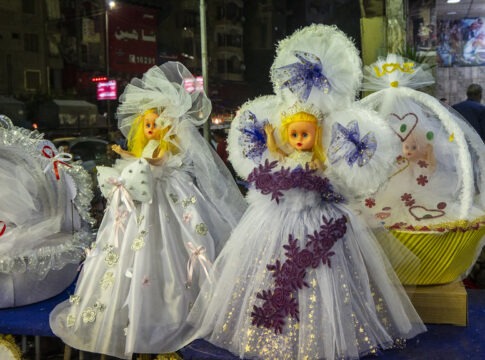The celebration of Al-Mawled Al-Nabawy, or the Prophet Mohammad’s birthday, holds a significant place in Egyptian culture, tracing its roots back to the Fatimid era between the 10th and 12th centuries AD. The Fatimids, known for their grand public ceremonies, were instrumental in establishing and popularizing this celebration. They organized massive festivities to foster unity and loyalty among their subjects, complete with elaborate processions, poetry recitations, and the distribution of sweets.
One captivating story from this era is about the origin of the iconic Mawlid sugar dolls. According to local legend, the Caliph’s wife once appeared at a public celebration dressed in a splendid gown, accompanied by the Caliph on horseback. Inspired by this sight, confectioners began creating sugar dolls and horse figures to commemorate the event. These sugar figures became immensely popular, symbolizing the royal couple and adding a touch of whimsy to the celebrations.
The Sufi orders in Egypt also played a significant role in the celebrations. Sufi gatherings, known as “Hadra,” featured participants engaging in dhikr (remembrance of God) and reciting poetry in praise of the Prophet Muhammad. These gatherings often attracted large crowds, blending spiritual devotion with communal joy.
One of the most enduring traditions associated with Al-Mawled El-Nabawy is the production and consumption of special sweets. This industry has flourished in Egypt, partly due to the unique skills Egyptians have developed in confectionery. Sweets like sugar-coated sesame, pistachios, and almond nuts are popular. Iconic figures such as the Mawlid doll and the sultan on a horse, made of sugar and nuts, are decorated with colored paper.
However, in modern times, the industry faces challenges, including declining demand due to the reduced purchasing power of consumers. Despite these obstacles, some confection factories, like those in Bab el-Bahr, an ancient district in downtown Cairo, continue to preserve the tradition. Workers, both male and female, take pride in their craft, knowing that their creations bring joy to many, especially children.
Bab el-Bahr has been a hub for Mawlid confections since the Fatimid era. One story tells of a famous confectioner named Hassan al-Zaghat, who inherited his trade from his ancestors. Despite modern challenges, Hassan and his fellow traders continue to produce and sell traditional sweets, keeping the centuries-old tradition alive. Their dedication is evident as they meticulously craft sugar dolls and horses, a sight that has become synonymous with the Mawlid celebrations.
According to recent data, the volume of Mawlid sweets sold annually in Egypt has seen fluctuations. While precise figures can vary, reports suggest that the demand for traditional sweets remains significant, even as new varieties enter the market. For example, in 2020, it was estimated that Egyptians spent over 1 billion EGP on Mawlid sweets, a testament to the enduring popularity of this tradition.
However, the industry has also seen a shift towards modern alternatives. Traditional sugar dolls and horses are becoming scarce, with plastic versions becoming more prevalent. Factories that still produce these traditional sweets face difficulties, such as a shortage of skilled artisans and rising production costs.
Al-Mawled El-Nabawy remains a vibrant and cherished celebration in Egypt, deeply rooted in history and tradition. From the grand processions of the Fatimid Caliphs to the enduring craftsmanship of confectioners in Bab el-Bahr, the historical stories and modern realities of this celebration highlight the rich cultural heritage of the Egyptian people. Despite modern challenges, the essence of Al-Mawled Al-Nabawy, reflected in the production and enjoyment of traditional sweets, continues to be a significant part of Egyptian culture.

